The Optavia Diet For Weight Loss: Efficacy, Tips, And Side Effects
Effectively shed those extra pounds with the guidance of expert coaches.
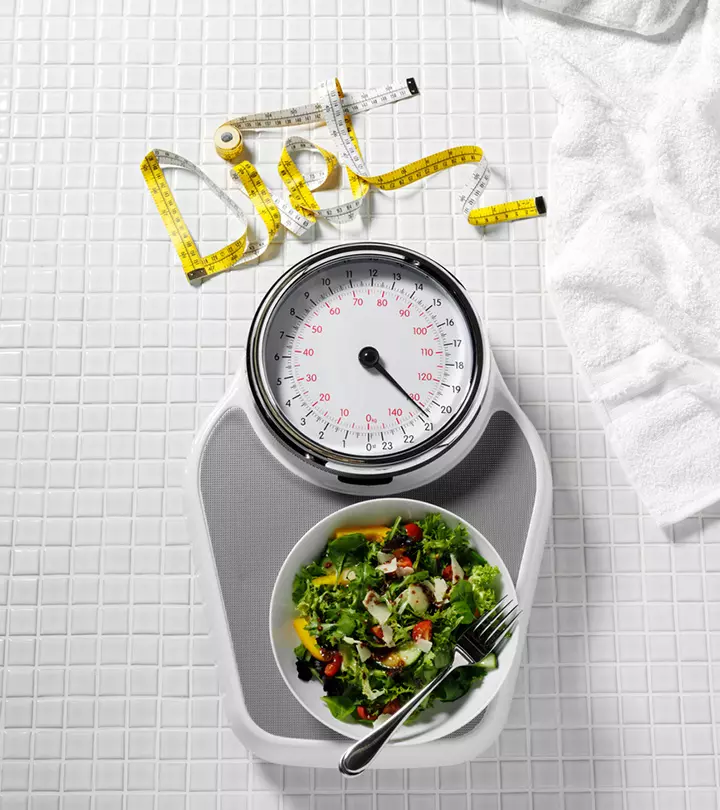
Image: iStock
The Optavia diet was created by Medifast, Inc., an American nutrition and weight loss company. It originally focused on providing safe and effective meal replacements for weight loss through Take Shape For Life (TSFL), its multi-level marketing branch. However, Dr. Wayne Scott Andersen, a physician and the co-founder of TSFL, eventually reshaped its approach. He understood that successful, long-term weight management involved more than just meal replacements; it meant cultivating healthy habits with the help of solid support.

In 2017, Take Shape For Life rebranded itself as Optavia and introduced the Optavia diet. While the diet doesn’t impose strict food restrictions, it focuses on controlling calorie intake and promoting specialized meals called “fuelings” for weight loss. But how effective is this diet in helping you achieve your weight loss goals? In this article, we have discussed all you need to know about the Optavia weight loss diet, including its health advantages, potential risks, and guidelines. Continue reading.
 At A Glance: Optavia Diet
At A Glance: Optavia Diet- Principle: A structured weight loss approach encouraging portion control and calorie restriction with the help of pre-packaged “fuellings” (800-1000 calories/day)
- Purpose: To promote weight management and healthy eating habits
- Who It Is For: Individuals who seek a structured weight loss plan with convenient pre-packaged meals
- Duration: Long-term, when adopted as a lifestyle
- Who Should Avoid: Pregnant or breastfeeding women, individuals with certain medical conditions such as diabetes, kidney issues, or eating disorders, and those who prefer whole, unprocessed foods
- Cons: May cause nutritional deficiencies, fatigue, irritability, and unhealthy weight loss and regain
In This Article
What Is The Optavia Diet?
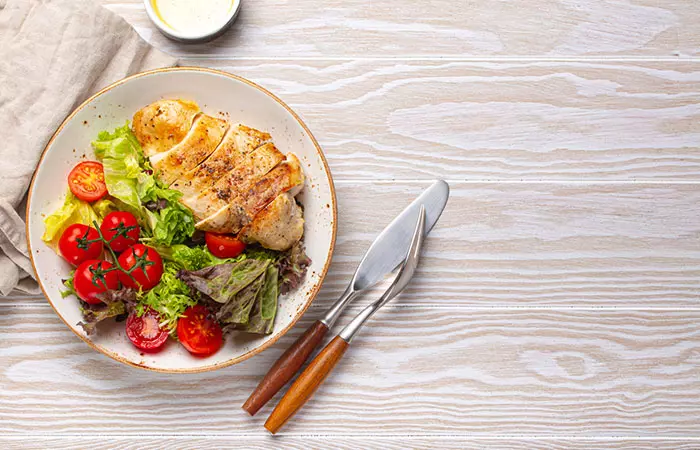
The Optavia Diet is a structured weight loss program that focuses on controlling calories through portioned meals. It involves pre-packaged “fuelings” combined with self-prepared “lean and green meals” that contain adequate lean proteins and vegetables for balanced nutrition. The diet also encourages eating smaller, frequent meals regularly and offers coaching support to instill healthy habits.
While the Optavia diet has gained popularity for its convenient yet structured approach to weight management, its long-term sustainability and overall effectiveness have been a subject of debate. Let’s take a moment to understand if the Optavia diet really stands out as its proponents claim.
Key Takeaways
- The Optavia diet is a structured weight loss program that provides clear guidelines and pre-packaged meal replacements (“fuelings”) for balanced nutrition. It also involves “lean and green meals”, which participants prepare themselves to complement the program.
- It offers coaching support for participants to help them stay on track with their weight loss goals.
- It includes a transition phase in which individuals gradually incorporate more self-prepared meals into their diet and learn sustainable eating habits for the long-term.
- Participants become part of a supportive community where they can engage with others on the same weight loss journey.
How Does The Optavia Diet Work?
The Optavia diet is based on the following key ideas:
- Fuelings: These form the core of the Optavia Diet. They are portion-controlled, pre-packaged meals that simplify controlling calorie intake.
- Meal Frequency: Participants usually consume five or six Optavia fuelings during the day, apart from one “lean and green” meal that comprises lean protein and non-starchy vegetables.
- Calorie Control: The Optavia diet is a low-calorie diet and typically provides 800 to 1,000 calories per day to promote significant weight loss.
- Gradual Phases: The program has phases of weight loss and transition. While the former targets weight loss, the latter reintroduces regular foods and reduces the dependence on Optavia fuelings.
- Personal Coaching: A certified Optavia coach helps individuals set goals, make healthy choices, and stay on track throughout their weight loss journey.
- Healthy Habits: The diet emphasizes not just weight loss but overall well-being by developing healthy habits with respect to sleep, hydration, exercise, and mindset.
- Community Support: Optavia also fosters a sense of belongingness among its participants through online support groups, virtual events, and resources where individuals can connect, share their experiences, and receive additional guidance.
- Maintenance: Once individuals reach their desired weight, the program offers maintenance plans to help them sustain their weight loss and continue practicing healthy habits.
 Did You Know?
Did You Know?Note: For individuals interested in a more flexible option, the Volumetrics diet offers a focus on low-calorie, nutrient-dense foods. This plan encourages eating foods with high water content, like fruits, vegetables, and soups, allowing you to feel full while consuming fewer calories.
It’s important to note that while the Optavia diet can be effective for weight loss, it may not be suitable for everyone. The very low-calorie nature of the diet requires close monitoring and must only be followed under the guidance of a healthcare professional. You also need to be aware of the foods to be included in this diet. We will look into the same in the following section!
Optavia Diet Foods List
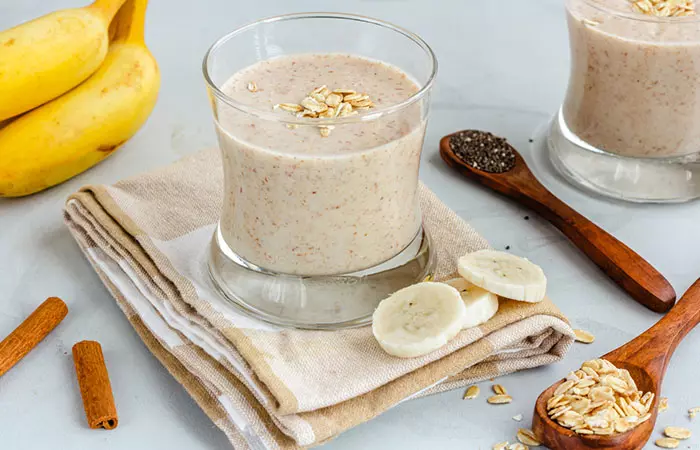
- Fuelings:
Chocolate, peanut butter, and fruit-and-nut bars
Shakes
Smoothies
Cereals
Soups
Puddings
Biscuits
Crispy snacks
Popcorn
- Lean And Green Meals:
Lean Protein Options (5-7 ounces)
Chicken or turkey breast (skinless)
Fish (tuna, mahi-mahi, salmon, or tilapia)
Shellfish (shrimp, crab, or scallops)
Beef steak, ground beef (95% lean)
Pork (loin or tenderloin)
Eggs or egg whites
Tofu, tempeh
Non-Starchy Vegetables (about 1.5 cups)
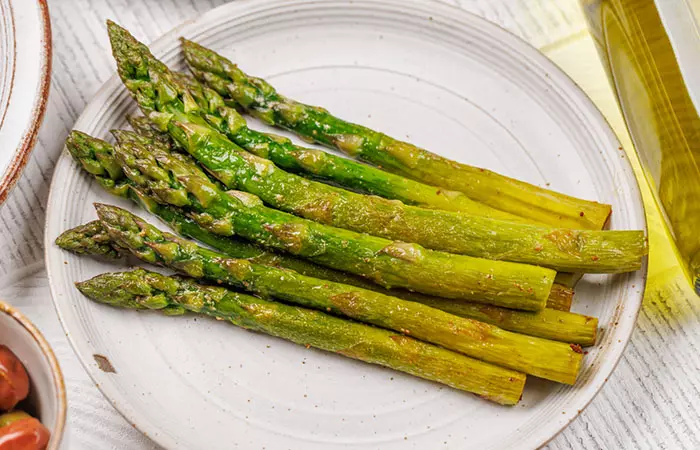
Asparagus
Spinach
Lettuce
Kale
Bell peppers
Cucumbers
Celery
Broccoli
Cauliflower
Eggplant
Zucchini
Summer squash
Green beans
Brussels sprouts
Healthy Fats (0-2 servings)
Olives or olive oil
Avocado
Nuts and seeds (in moderation)
Salad dressings (low-carb)
- Approved Condiments:
Mustard
Vinegar
Hot sauce
Herbs
Low-calorie condiments
- Non-Caloric Beverages:
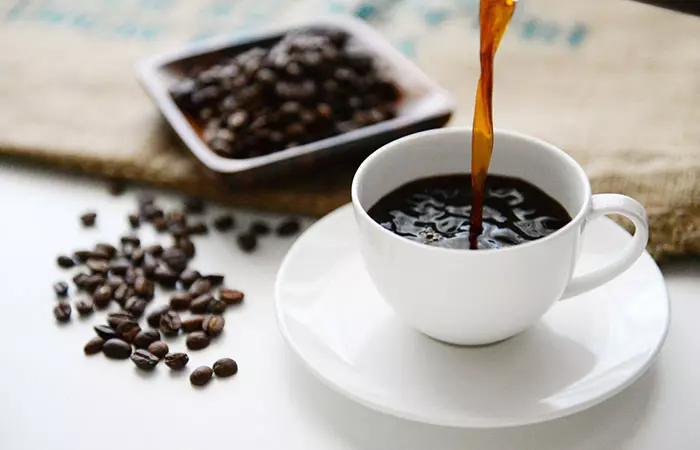
Black coffee
Herbal teas (unsweetened)
Diet sodas (in moderation)
Water
- Snacks (sugar-free, optional):
Raw vegetables
Pickles
Gelatin
Popsicles
Note: Optavia’s specific meal plans and products may change over time. So, it’s essential to refer to the latest materials and guidance provided by the program.
 Trivia
TriviaNote: If you are seeking a convenient and straightforward plan, the Slim Fast diet could be the solution. This plan revolves around meal replacements, such as shakes and bars, combined with a single healthy meal each day.
The Optavia diet has various plans. But the above breakdown is based on its most common plan: the Optimal Weight 5 & 1 Program, which involves eating five Optavia “fuelings” and one “lean and green meal” each day. In the next section, discover a sample Optavia diet plan that can transform not just your weight but your overall well-being.
Optavia Diet Plan
Here’s a sample Optavia diet plan based on the popular 5 & 1 Program that consists of five Optavia “fuelings” and “one lean and green meal” per day:
- Breakfast
Optavia Fueling Option 1: Optavia Fueling Shake
A glass of water or black coffee (unsweetened)
- Mid-Morning Snack
Optavia Fueling Option 2: Optavia Fueling Bar
A glass of water or a cup of herbal tea
- Lunch
Optavia Fueling Option 3: Optavia Fueling Soup
A glass of water
- Afternoon Snack
Optavia Fueling Option 4: Optavia Fueling Snack
A glass of water or a cup of herbal tea
- Dinner: Lean & Green Meal
Grilled chicken breast (skinless, 5-7 ounces)
Steamed broccoli (1/2 cup)
Grilled asparagus (1 cup)
Mixed salad with lettuce, cucumber, and cherry tomatoes (1 cup)
1 tbsp of olive oil and vinegar to dress the salad
A cup of herbal tea or a glass of water
- Late Afternoon/Evening Snack
Optavia Fueling Option 5: Optavia Fueling Brownie
A cup of herbal tea, preferably caffeine-free
While the Optavia Diet can be effective for weight loss, it may not be suitable for everyone. Also, individual results can vary. Hence, it’s crucial to choose a plan that suits your specific health requirements and lifestyle and to approach weight loss in a balanced manner. Your Optavia coach can provide personalized recommendations and support to help you achieve your weight loss goals while correctly following the plan. Additionally, you also need a collection of delicious yet sustainable recipes to help you maintain your weight loss. We list a few such recipes in the next section.
Optavia Diet Recipes
1. Turkey And Veggie Stir-Fry
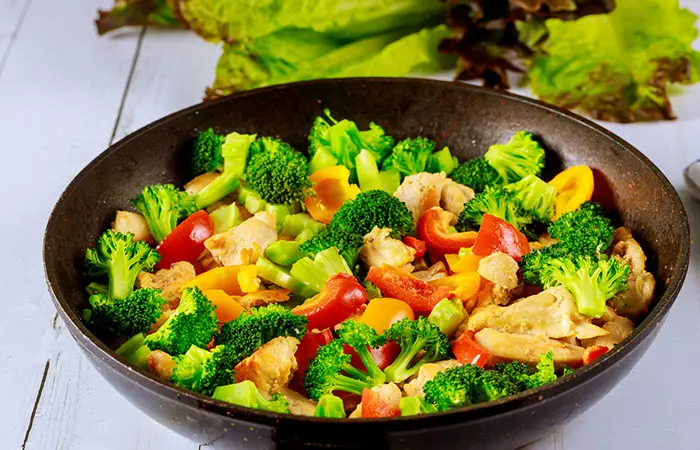
Calories per serving: 250-300, approximately
Serves: 1
Prep Time: 10 minutes
Cooking Time: 15 minutes
Ingredients
- 1 turkey cutlet (5-7 ounces)
- 1 cup of broccoli florets
- 1/2 cup of bell peppers, sliced
- 1/2 cup of snap peas
- 1 clove of garlic, minced
- 1 tsp of olive oil
- Salt and pepper, to taste
- 1 tsp of low-sodium soy sauce (optional)
How To Prepare
- Heat the olive oil in a non-stick skillet over medium-high heat.
- Season the turkey cutlet with salt and pepper and add it to the skillet.
- Cook for about 4-5 minutes per side or until cooked through. Remove from the skillet and set aside.
- Add garlic and sauté for about 30 seconds in the same skillet.
- Add broccoli, bell peppers, and snap peas. Stir-fry for about 5-7 minutes or until the vegetables are tender-crisp.
- Slice the cooked turkey cutlet into thin strips and add it to the stir-fry. Cook for an additional 2 minutes to heat through.
- Drizzle with low-sodium soy sauce for added flavor.
- Serve hot.
2. Baked Lemon Herb Cod With Steamed Asparagus

Calories per serving: 250-300, approximately
Serves: 1
Prep Time: 10 minutes
Cooking Time: 20 minutes
Ingredients
- 1 cod filet (5-7 ounces)
- 1/2 lemon, juiced
- 1 tsp of olive oil
- 1/2 tsp of dried herbs (basil, thyme, or rosemary)
- 1 cup of asparagus spears
- Salt and pepper, to taste
How To Prepare
- Preheat the oven to 375°F (190°C).
- Place the cod filet on a piece of aluminum foil.
- Drizzle olive oil and lemon juice over the cod, then sprinkle dried herbs, salt, and pepper.
- Seal the aluminum foil to create a packet.
- Bake the cod in the preheated oven for about 15-20 minutes or until it flakes easily with a fork.
- Steam the asparagus spears until they are tender, for about 4-5 minutes.
- Serve the baked cod with steamed asparagus.
3. Tofu And Vegetable Stir-Fry

Calories per serving: 250-300, approximately
Serves: 1
Prep Time: 15 minutes
Cooking Time: 10 minutes
Ingredients
- 1/2 block of firm tofu (about 7 ounces), cubed
- 1 cup of mixed vegetables (bell peppers, broccoli, carrots)
- 1 clove of garlic, minced
- 1 tsp of sesame oil
- Low-sodium soy sauce, to taste
- Salt and pepper, to taste
How To Prepare
- Heat sesame oil in a non-stick skillet over medium-high heat.
- Add minced garlic and sauté for about 30 seconds.
- Add cubed tofu to the skillet and cook for 3-4 minutes, stirring occasionally, until it starts to brown.
- Add mixed vegetables and continue to stir-fry for an additional 5-6 minutes or until the vegetables are tender-crisp.
- Season with low-sodium soy sauce, salt, and pepper to taste.
- Serve hot.
4. Zucchini Noodles With Pesto Grilled Chicken
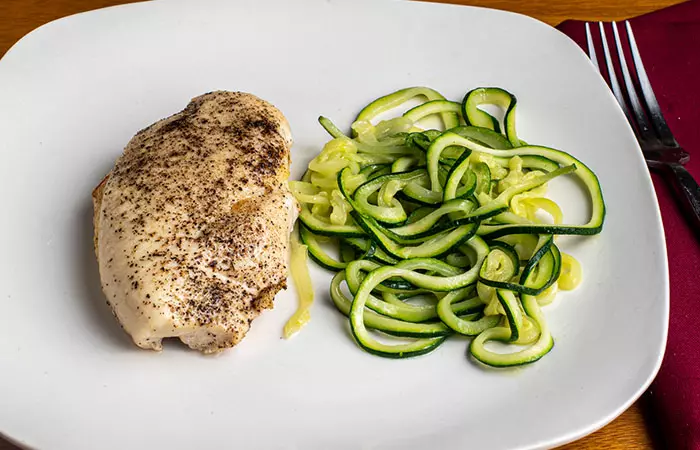
Calories per serving: 350, approximately
Serves: 2
Prep Time: 15 minutes
Cooking Time: 15 minutes
Ingredients
- 2 boneless, skinless chicken breasts (5-7 ounces each)
- 2 medium zucchinis
- 2 tbsp of pesto sauce (opt for a low-carb, sugar-free version)
- 1 tbsp of olive oil
- Salt and pepper, to taste
How To Prepare
- Preheat grill or grill pan on medium-high heat.
- Season chicken breasts with salt and pepper.
- Grill chicken for about 6-7 minutes per side or until it reaches an internal temperature of 165°F (74°C). Let it rest for a few minutes, then slice.
- Make zucchini noodles using a spiralizer or a vegetable peeler.
- Heat olive oil in a large skillet over medium heat.
- Add zucchini noodles and sauté for 2-3 minutes, just until they are slightly softened.
- Toss the zucchini noodles with pesto sauce.
- Serve grilled chicken over zucchini noodles.
 Pro Tip
Pro TipThe Optavia diet equips you with the right tools to achieve optimal health. Check out the benefits of this diet to understand more.
Benefits Of The Optavia Diet
- Has A Structured Approach: The diet provides a clear and structured meal plan, making it easier for individuals to follow and stick to a weight loss regimen.
- Is Convenient: Optavia “fuelings” are pre-packaged and easy to prepare, making meal planning and preparation more convenient for those with busy lifestyles.
- Provides Coaching: Many people find value in the coaching support provided by Optavia as the coaches offer guidance and motivation throughout the weight loss journey.
- Offers A Balanced Nutrition: Optavia aims to provide balanced nutrition through its “fuelings”, ensuring that individuals receive essential vitamins and minerals while losing weight.
- Encourages Gradual Transition: The program includes a transition phase in which individuals gradually reduce the number of “fuelings” and incorporate more self-prepared meals for long-term weight maintenance.
- Fosters Belongingness And Accountability: Optavia participants often become part of a supportive community with others on the same weight loss journey.
- Encourages Healthy Habits: Individuals learn about healthy eating habits, portion control, and the importance of regular physical activity through the coaching and education components of the program (1).
- Offers Customization: While there is a structured plan, Optavia offers some flexibility in choosing “fuelings” and “lean and green meals”. This helps individuals stick to the program.
The Optavia diet is about embracing a sustainable lifestyle. As with any weight loss program, long-term success often depends on a person’s ability to maintain healthy eating habits and lifestyle changes after transitioning off the program. Scroll down to know more about its weight loss program and its potential side effects.
The Optavia Diet Weight Loss Program
The Optavia diet focuses on portion control, balanced nutrition, and accountability, and helps individuals achieve sustainable weight loss (2). The program allows one to choose their own “lean and green meals”. What makes it more unique is its coaching support for individuals that helps them stay motivated on their journey to better health.
The key to the Optavia diet is consistency and sticking to the plan. Clear guidelines and a supportive community help build healthy habits for the long term. Although the pre-packaged meals make it relatively straightforward, if you ever feel the need to stray, reach out to your Optavia coach or consider adjusting the plan to better suit your needs.
Long-Term Side Effects Of The Optavia Diet
Long-term side effects of the Optavia diet can vary from person to person and may depend on individual factors such as underlying health conditions and specific choices made during and after the diet.
Mary Sabat, a Registered Dietitian, says, “The Optivia diet is mostly processed foods made from poor quality ingredients that in the long run will make people sicker not healthier. They may lose weight but they will pay a price with their health. They also do not learn how to fuel themselves with real food other than the one meal a day so it reinforces why many people are overweight and sick to begin with. In the long run, people have not changed their lifestyle they have done a “diet” and diets do not produce long-term weight loss and health.”
While many people have successfully used the Optavia diet for weight loss, some potential issues can arise in the long run. These include the following:
- May Cause Nutritional Deficiencies: The Optavia diet relies heavily on pre-packaged meals and while they offer balanced nutrition, solely depending on them for a long time may cause nutritional deficiencies in some individuals.
- May Cause Metabolic Changes: Rapid weight loss diets can impact your metabolism (3). Some individuals may experience changes in their metabolic rate after completing the program.
- May Lead To Digestive Issues: Rapid changes in dietary patterns, which are a part of the Optavia diet, may lead to digestive issues like bloating, constipation, or diarrhea.
- May Lead To Muscle Loss: Extremely low-calorie diets can lead to muscle loss, especially if not combined with adequate protein intake and exercise (4). Preserving muscle mass is crucial for one’s long-term health and metabolism.
- May Lead To Weight Regain: The lack of a well-structured transition plan may cause individuals to experience weight regain after completing the program.
- May Have A Social And Emotional Impact: Long-term restriction and reliance on meal replacements may affect one’s relationship with food and impair enjoyment at social gatherings.
- May Have Psychological Effects: Some individuals may develop an unhealthy relationship with food or experience emotional distress. Weight loss diets with intensive lifestyle interventions have been generally found to affect an individual’s mental health (5).
- May Encourage Reliance On Processed Foods: Overreliance on processed meal replacements can diminish the understanding or practice of preparing and enjoying whole, fresh foods.
- Potential Financial Impacts: The Optavia diet often involves purchasing pre-packaged meals and snacks, which can be a significant financial burden in the long term. Relying on these products can make it difficult to transition to a sustainable, affordable diet after completing the program.
Discuss a plan for transitioning to a balanced, long-term eating pattern with your dietician or coach while you are on the diet. This can help avoid unrealistic expectations and maintain continuity. Keep reading to know what to consider before and after starting the diet, and learn some tips and tricks for maintaining the diet.
Note: The Dr. Nowzaradan diet, designed by the renowned bariatric surgeon, is a noteworthy alternative. This diet is known for its strict calorie limits and high protein focus, aiming to prepare individuals for significant weight loss or bariatric surgery.
Things To Keep In Mind Before And After The Optavia Diet

Here are some important things to consider before and after the Optavia diet:
Before Starting The Optavia Diet:
- Understand The Program: Familiarize yourself with the Optavia diet program, including the meal plans, guidelines, and any potential side effects. Knowing what to expect can help you prepare mentally.
- Set Realistic Goals: Have realistic expectations about your weight loss goals and the pace of your progress. Rapid weight loss may not be sustainable or healthy for everyone.
- Stock Up On Fuelings: Make sure you have an ample supply of Optavia fuelings to avoid interruptions in your meal plan.
- Clear Your Pantry: Remove tempting, off-plan foods from your kitchen to reduce the temptation to stray from the diet.
After Completing The Optavia Diet:
- Transition Gradually: Transition off the Optavia Diet gradually and under the guidance of your coach or healthcare provider. Sudden shifts in one’s diet can lead to weight regain.
- Maintain A Healthy Lifestyle: Continue to prioritize a balanced diet and regular physical activity to maintain your weight loss and overall health.
- Monitor Your Progress: Keep track of your weight and any changes in your health. Regular monitoring can help you catch any issues early on and make necessary adjustments.
- Be Mindful Of Food Choices: Pay attention to your food choices and portion sizes. Avoid returning to old habits that may have contributed to weight gain.
- Stay Hydrated: Continue to drink plenty of water, as proper hydration is crucial for your overall well-being.
- Seek Professional Guidance: If you encounter challenges or experience any health concerns after completing the program, consult a healthcare provider or dietitian for guidance.
Weight maintenance is a long-term commitment. Approaching your journey with patience and a balanced mindset can lead to long-term success.
Tips And Tricks To Maintain The Optavia Diet
Here are some strategies to help you stay on track:
- Plan Ahead: Plan your “lean and green meals” and Optavia “fuelings” in advance. Having a meal plan can prevent last-minute unhealthy choices.
- Keep Healthy Snacks At Hand: Have approved, portion-controlled snacks readily available when you feel hungry between meals.
- Stay Hydrated: Sometimes, thirst can be mistaken for hunger. So, staying hydrated by drinking plenty of water can help control unnecessary snacking.
- Use Approved Condiments: Explore different low-calorie and sugar-free condiments and seasonings to add flavor to your meals without adding any extra calories.
- Read Labels: Be mindful of the nutritional information on food labels, especially when preparing “lean and green meals”. Choose low-carb and low-fat options.
- Stay Connected: Engage with your Optavia coach and the community. Sharing your progress and challenges with others can provide support and motivation.
- Track Your Progress: Keep a food journal to track what you eat and how you feel. This can help identify patterns and make necessary adjustments.
- Eat Mindfully: Eat slowly and savor your meals. Pay attention to your body’s hunger and fullness cues to prevent overeating.
- Exercise Regularly: While exercise isn’t a strict part of the Optavia Diet, incorporating physical activity into your routine can boost your weight loss journey and overall health.
- Revisit Your Goals: Regularly review your weight loss goals and remind yourself why you started the Optavia Diet. Visualize your success to stay motivated.
- Stay Positive: Every weight loss journey has its ups and downs. Celebrate your victories, no matter how small, and try not to be too hard on yourself if you have a challenging day.
- Allow Treats In Moderation: Occasionally indulging in a small treat that fits within your daily calorie allowance can help you avoid feeling deprived.
As everyone’s weight loss journey is unique, it’s essential to find an approach that works best for you. Listen to your body, stay consistent, and seek support when needed to successfully follow the Optavia diet.
Infographic: 7 Nutrient-Rich Foods To Eat On The Optavia Diet
Nutrient-rich foods, such as lean proteins, veggies, and whole grains, give your body vital vitamins and minerals that are essential for your overall well-being. They help create balanced meals, reduce extra snacking, and keep you feeling full and energized during this low-calorie diet. Check out the infographic below to learn about the 7 nutrient-rich foods to include in the Optavia diet.
Some thing wrong with infographic shortcode. please verify shortcode syntaxFrequently Asked Questions
Can you eat tomatoes when you are on the Optavia diet?
Yes. Tomatoes are considered a non-starchy vegetable and can be included in your “lean and green meals” as part of the program.
How much weight do you lose on the Optavia diet?
Individuals may lose an average of 2 to 5 pounds per week during the initial phases of the program. However, this varies from person to person.
Who should not follow the Optavia diet?
It may not be suitable for individuals with certain medical conditions, such as a kidney disease, dietary restrictions, as well as pregnant or nursing women. Consulting a registered dietician is recommended before starting the program to ensure it is safe and appropriate for you.
Do people regain weight after Optavia?
Some individuals may regain weight after the Optavia diet, especially if they revert to previous eating habits or don’t follow a maintenance plan. Long-term success depends on adopting sustainable and healthy eating habits after the diet.
The Optavia diet is all about balance. Whether you’re looking to shed those extra pounds or simply want to embrace a healthier lifestyle, it could serve as a good start. Check out the video below for a detailed review of the diet by an obesity medicine specialist and trusted expert.
References
Articles on StyleCraze are backed by verified information from peer-reviewed and academic research papers, reputed organizations, research institutions, and medical associations to ensure accuracy and relevance. Read our editorial policy to learn more.
- Healthy habits associated with successful weight loss maintenance on a commercial program: learnings from a research survey Food and Nutrition Sciences
https://www.scirp.org/journal/paperinformation?paperid=117336 - Randomized controlled trial assessing two commercial weight loss programs in adults with overweight or obesity Obesity Science and Practice
https://www.ncbi.nlm.nih.gov/pmc/articles/PMC6381299/ - Physiological process of fat loss Bulletin of the National Research Centre
https://bnrc.springeropen.com/articles/10.1186/s42269-019-0238-z - Weight loss strategies and the risk of skeletal muscle mass loss nutrients MDPI
https://www.mdpi.com/2072-6643/13/7/2473 - Association of changes in mental health with weight loss during intensive lifestyle intervention: does the timing matter? Obesity Science and Practice
https://www.ncbi.nlm.nih.gov/pmc/articles/PMC5893461/
Read full bio of Mary Sabat
Read full bio of Aparna Mallampalli
Read full bio of Ravi Teja Tadimalla
Read full bio of Sindhu Koganti
















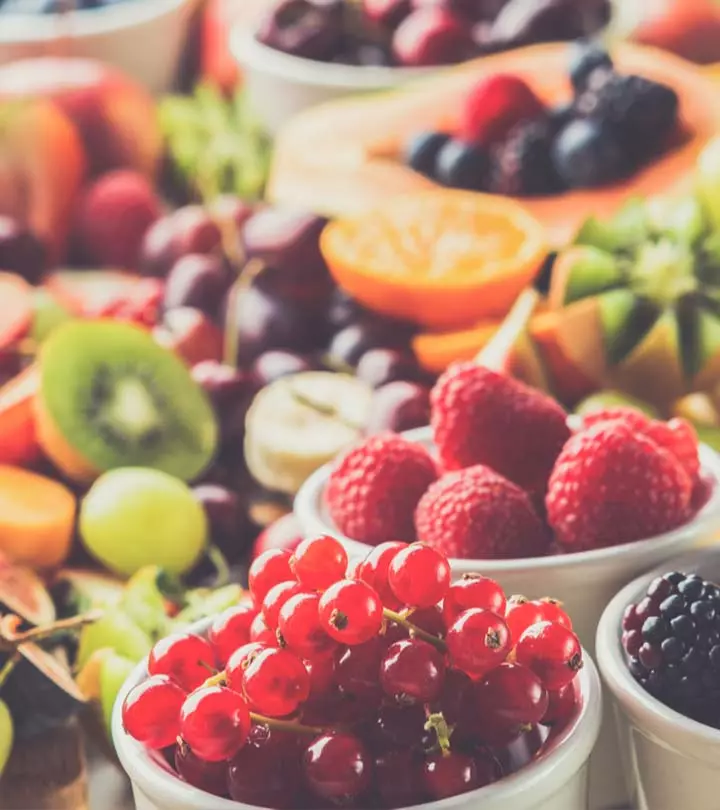

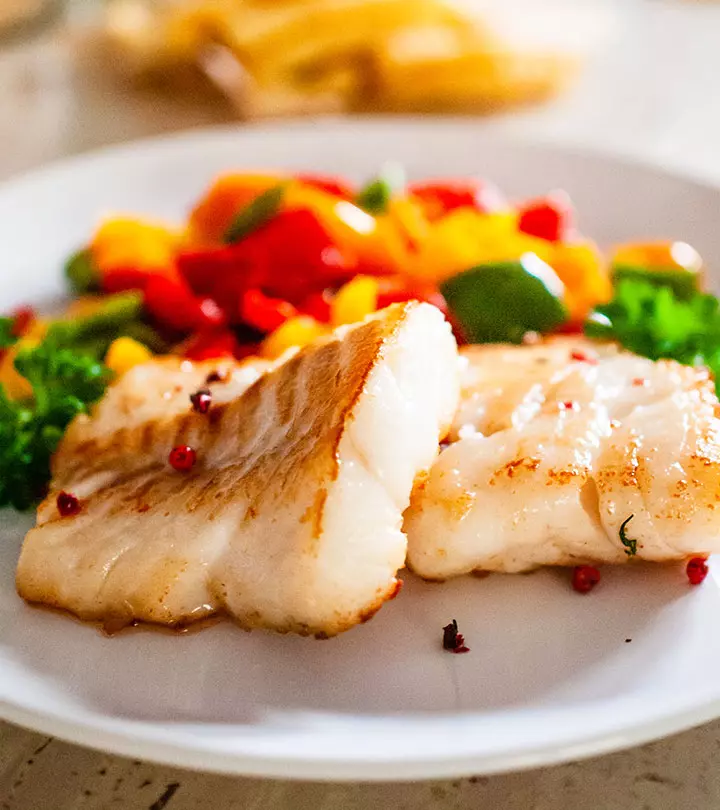



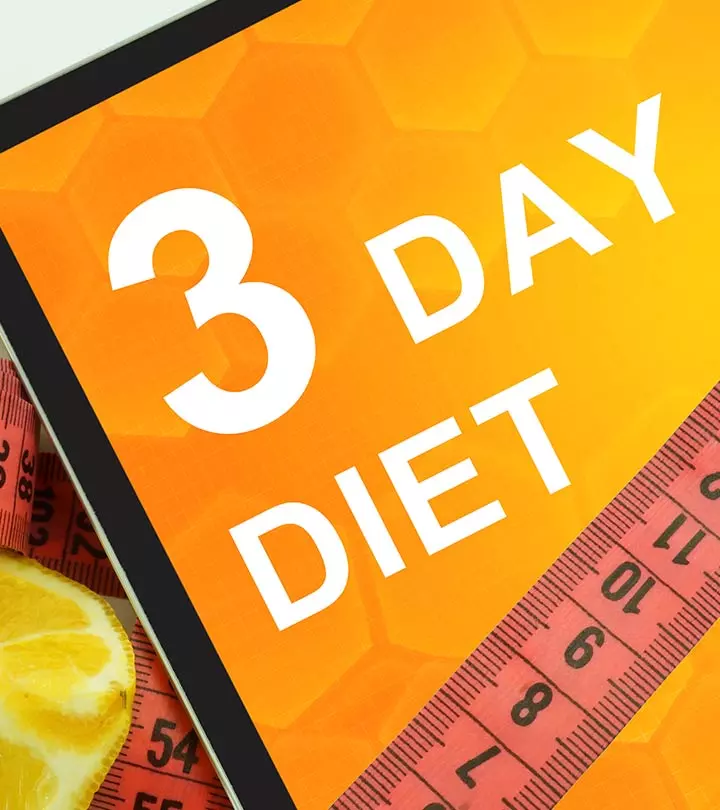



Community Experiences
Join the conversation and become a part of our empowering community! Share your stories, experiences, and insights to connect with other beauty, lifestyle, and health enthusiasts.